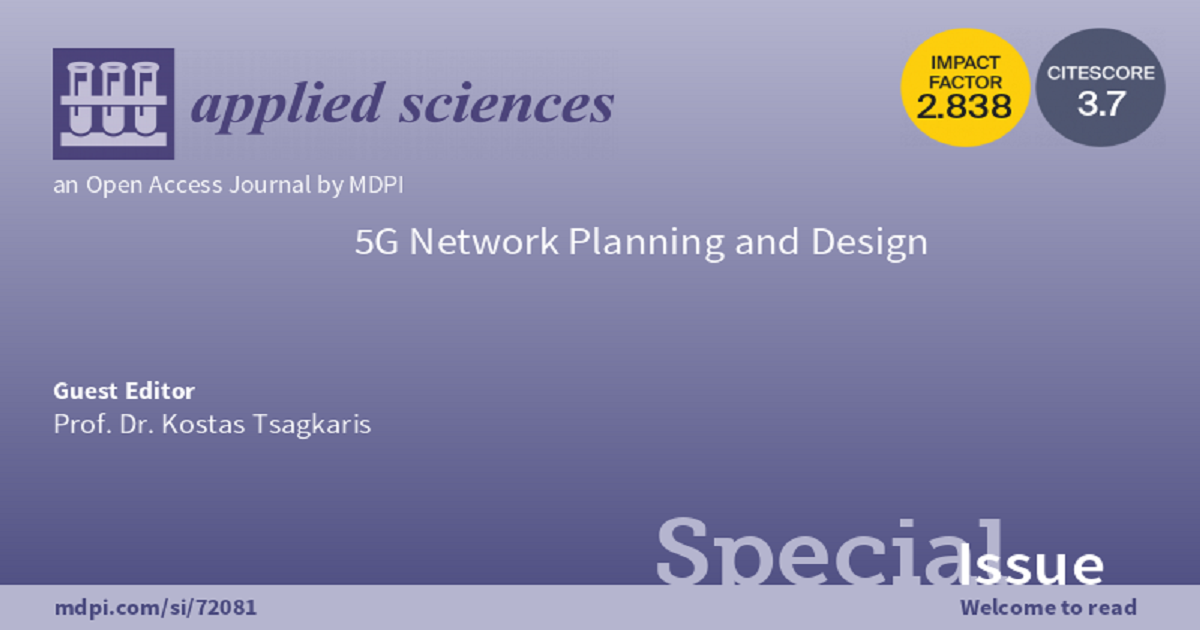5G Network Planning and Design
A special issue of Applied Sciences (ISSN 2076-3417). This special issue belongs to the section "Electrical, Electronics and Communications Engineering".
Deadline for manuscript submissions: closed (20 February 2023) | Viewed by 26787

Special Issue Editor
Special Issue Information
Dear Colleagues,
5G is around the corner, and there is a general consensus that it is poised to change the world as we know it! It promises a wireless future that will offer unprecedented connectivity for people, places, and things everywhere. Compared with former generations, 5G has been greatly enhanced; hence, it will need to address quite stringent requirements in order to live up to its potential and hyped expectations.
New frequency bands; spectrums and their dynamic disposition to public and private organizations; and radio technologies that exploit advancements in massive MIMO and move from sector-level wide beams to user-centric, narrow, and dynamic beams, as well as a network architecture offering exceptional new levels of reliability, performance, flexibility, and cost-effectiveness, are some of the major features that have been or will need to be developed to support the myriad of future 5G application scenarios.
Most importantly, 5G networks are primarily oriented to users and verticals. Capitalizing on software and virtualized infrastructure, they will be flexible enough to accommodate for various heterogeneous and diverse applications and vertical requirements, in terms of speed, latency, dependability, etc. Innovations like 5G network slicing will let operators provision segments of their network capacity to deliver specific quality of service (QoS) levels to specific customers, whether that be a smart home, an Internet of Things (IoT)-based industry, or a connected car.
On the other hand, new use cases are going to appear that will consider the need to incorporate various technology innovations (5G-enabled localization accuracy, advances in UAV technology, big-data and AI/machine/deep learning technology, etc.), the need for planning for critical situations (e.g., COVID-9 pandemics), and the opportunity to realize older objectives, such as the replacement of traditional, costly fiber-based rollouts by fixed wireless access based on 5G, etc.
This Special Issue, “5G Network Design and Planning”, recognizes these challenges, and raises opportunities and invites active researchers and industrial professionals to submit original articles focusing on innovative algorithms and methodologies, with a solid theoretical background and practicability, that will optimally exploit the latest advancements of 5G towards achieving the utmost efficiency in the way that 5G networks (Core, Backhaul/Fronthaul, and Access) are designed, planned, and eventually operated.
Prof. Dr. Kostas Tsagkaris
Guest Editors
Manuscript Submission Information
Manuscripts should be submitted online at www.mdpi.com by registering and logging in to this website. Once you are registered, click here to go to the submission form. Manuscripts can be submitted until the deadline. All submissions that pass pre-check are peer-reviewed. Accepted papers will be published continuously in the journal (as soon as accepted) and will be listed together on the special issue website. Research articles, review articles as well as short communications are invited. For planned papers, a title and short abstract (about 100 words) can be sent to the Editorial Office for announcement on this website.
Submitted manuscripts should not have been published previously, nor be under consideration for publication elsewhere (except conference proceedings papers). All manuscripts are thoroughly refereed through a single-blind peer-review process. A guide for authors and other relevant information for submission of manuscripts is available on the Instructions for Authors page. Applied Sciences is an international peer-reviewed open access semimonthly journal published by MDPI.
Please visit the Instructions for Authors page before submitting a manuscript. The Article Processing Charge (APC) for publication in this open access journal is 2400 CHF (Swiss Francs). Submitted papers should be well formatted and use good English. Authors may use MDPI's English editing service prior to publication or during author revisions.
Keywords
- customer/user experience-centric
- network software/cloud architectures
- big data-/machine learning-based planning
- QoS/slicing
- IoT
- UAV/drones
- geo/localization techniques enabled by 5G and location-based 5G planning
- planning for crisis situations
- spectrum/DSA and local industrial networks
- migration planning/rollout and cooperation with legacy
Benefits of Publishing in a Special Issue
- Ease of navigation: Grouping papers by topic helps scholars navigate broad scope journals more efficiently.
- Greater discoverability: Special Issues support the reach and impact of scientific research. Articles in Special Issues are more discoverable and cited more frequently.
- Expansion of research network: Special Issues facilitate connections among authors, fostering scientific collaborations.
- External promotion: Articles in Special Issues are often promoted through the journal's social media, increasing their visibility.
- e-Book format: Special Issues with more than 10 articles can be published as dedicated e-books, ensuring wide and rapid dissemination.
Further information on MDPI's Special Issue policies can be found here.





